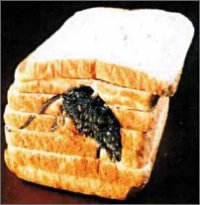How Many Insect Parts and Rodent Hairs are Allowed in Your Food?
More Than You Think ... and Maybe Than You Want to Know!
by www.SixWise.com
How about a little rat hair with your peanut butter? A fly head with your macaroni and cheese? Though it may sound disgusting, these things and other gross filth the Food and Drug Administration (FDA) calls "natural contaminants" are indeed allowed and present in your food.
|

Gross but true: A certain number of rodent hairs are allowed in the food you eat. (A whole mouse, however, is not.) |
In fact, so common are these contaminants that the FDA has published a booklet detailing the so-called "Food Defect Action Levels," which were needed, according to the FDA, " ... because it is economically impractical to grow, harvest, or process raw products that are totally free of non-hazardous, naturally occurring, unavoidable defects."
Surely, anyone who's ever collected lettuce from a home garden, picked apples right from the tree or strawberries right from the vine has gotten the unpleasant surprise of finding a spider, worm or other "natural contaminant" in their harvest. But in these cases, we're more accepting, or at least, more expecting, of finding an unwanted guest, and we're free to inspect each item for ourselves.
But what about when it comes to processed foods? Is there really any way to know how many insect parts have been ground right up with the rest of the ingredients? Probably not.
Think insect parts and rodent hairs are more of a rarity? Think again. An Ohio University fact sheet estimates that we eat from one to two pounds of insects each year, and without knowing it.
This is Gross, but is it Dangerous?
Quite the contrary. "They're actually pretty healthy," says Dr. Philip Nixon, an entomologist at the University of Illinois, in regard to insects, "If we were more willing to accept certain defect levels such as insects and insect parts, growers could reduce pesticide usage. Some of the spraying that goes on is directly related to the aesthetics of our food."
The FDA agrees that it's reasonable to accept more natural defects in our food in lieu of increasing the amount of pesticides sprayed on them:
"The alternative to establishing natural defect levels in some foods would be to insist on increased utilization of chemical substances to control insects, rodents and other natural contaminants. The alternative is not satisfactory because of the very real danger of exposing consumers to potential hazards from residues of these chemicals, as opposed to the aesthetically unpleasant but harmless natural and unavoidable defects."
However, there may be one health area that's been overlooked. According to Judy Tidwell, an economic service specialist at a state social services office in the Southeast United States who has struggled with allergies, trace amounts of insect parts that have been ground into food items ranging from strawberry jam to spaghetti sauce can affect people with allergies and asthma.
"We throw away the products that we see are infested. Just think how many we consume because we didn't notice they were infested. Ingesting insect material may cause stomach disorders, as well as allergic reactions," she says.
How Many Rodent Hairs and Insect Parts Are In ...
|

The FDA's action level for peanut butter is 30 or more insect fragments or one or more rodent hairs per 100 grams. |
Here is a very brief sampling of the FDA's Food Defect Action Level list. They begin investigation when foods reach the action level they've set. According to the FDA, typical foods contain about 10 percent of the action level, but others say they contain more like 40 percent.
CHOCOLATE AND CHOCOLATE LIQUOR
-
Insect filth: Average is 60 or more insect fragments per 100 grams when 6 100-gram subsamples are examined OR any 1 subsample contains 90 or more insect fragments
-
Rodent filth: Average is 1 or more rodent hairs per 100 grams in 6 100-gram subsamples examined OR any 1 subsample contains 3 or more rodent hairs
CITRUS FRUIT JUICES, CANNED
RED FISH AND OCEAN PERCH
MACARONI AND NOODLE PRODUCTS
PEANUT BUTTER
POPCORN
-
Rodent filth: 1 or more rodent excreta pellets are found in 1 or more subsamples, and 1 or more rodent hairs are found in 2 or more other subsamples OR 2 or more rodent hairs per pound and rodent hair is found in 50% or more of the subsamples OR 20 or more gnawed grains per pound and rodent hair is found in 50% or more of the subsamples
WHEAT FLOUR
Can these things be avoided? To avoid all unsavory food components, it seems, would be to stop eating all together. And perhaps we're just being too squeamish. After all, as Dr. Manfred Kroger, a professor of food science at Pennsylvania State University, says, "Let's face it, much of our food comes from nature, and nature is not perfect."
Recommended Reading
Why are More Boys than Girls Being Born?
Those Who Don't Diet are Better at Improving Health Than Those Who Do Diet
U.S. FDA: Food Defect Action Levels
News-Leader.com: Brace Yourself: There's Filth in the Food You Eat
Please Don't Eat the Aphids!